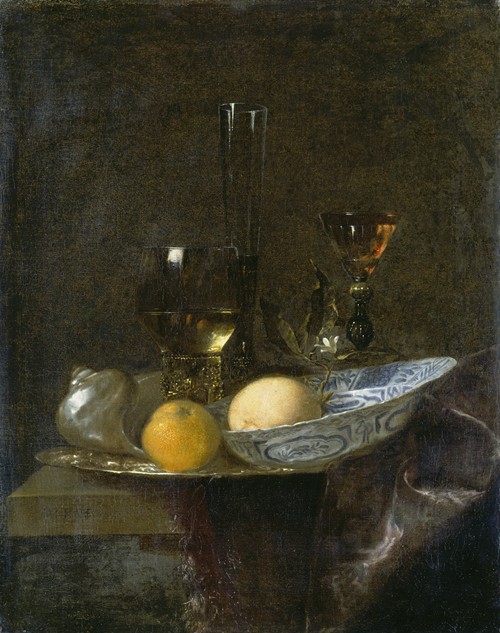


Usually, a damask cloth or tapestry is draped upon a table on which there is tableware, with gold and silver vessels, many of which have been identified as work of specific goldsmiths, such as Johannes Lutma. Kalf's magnificent still life paintings vary little in their structure, and most of them actually feature the same objects. The type of still life that Kalf painted was called 'pronkstilleven'. Kalf was one of the great Dutch masters of still life painting. Like other still lifes of this period, these paintings were usually expressing vanitas allegories. WILLEM KALF (1622-1693) 'Still Life with Nautilus Cup', 1662 (oil on canvas) W illem Kalf was born in Rotterdam, worked for a while in Paris, before he finally settled in Amsterdam. During the 1640s, Kalf further developed the banketje into a novel form of sumptuous and ornate still life (known as pronkstilleven), depicting rich groupings of gold and silver vessels. The semi-monochrome still lifes which Kalf created in Paris from a link to the banketjes or 'little banquet pieces' painted by such Dutch artists as Pieter Claesz, Willem Claeszoon Heda and others in the 1630s. Kalf's rustic interiors had a large influence on French art in the circle of the Le Nain brothers. The only indication of the French origin of the paintings are a few objects that Flemish exponents of the same genre would not have pictured in their works. Though painted in Paris, those pictures belong to a pictorial tradition practiced primarily in Flanders in the early 17th century, by such artists as David Teniers the Younger. Figures usually appeared only in the blurred obscurity of the background. Kitchen Still life, Dresden, Gemäldegal Alte Meister). Kalf's rustic interiors are typically dominated by groups of vegetables, buckets, pots and pans, which he arranged as a still life in the foreground (e.g. In Paris he painted mainly small-scale rustic interiors and still lifes. In the late 1630s, Willem Kalf traveled to Paris and spent time in the circle of the Flemish artists in Saint-Germain-des-Prés, Paris. Kalf was born into a prosperous patrician family in Rotterdam, where his father, a cloth merchant, held municipal posts as well. van Gelder's important archival research has established the painter's correct place and date of birth. He was previously thought to have been born in 1622, but H. Willem Kalf was born in Rotterdam, in 1619.

Life and work Pronk Still Life with Holbein Bowl, Nautilus Cup, Glass Goblet and Fruit Dish Willem Kalf, Still-Life, Louvre, 1660. Later in his life, Kalf became an art dealer and appraiser. Willem Kalf (1619 – 31 July 1693)was a Dutch Golden Age painter who specialized in still lifes.


 0 kommentar(er)
0 kommentar(er)
